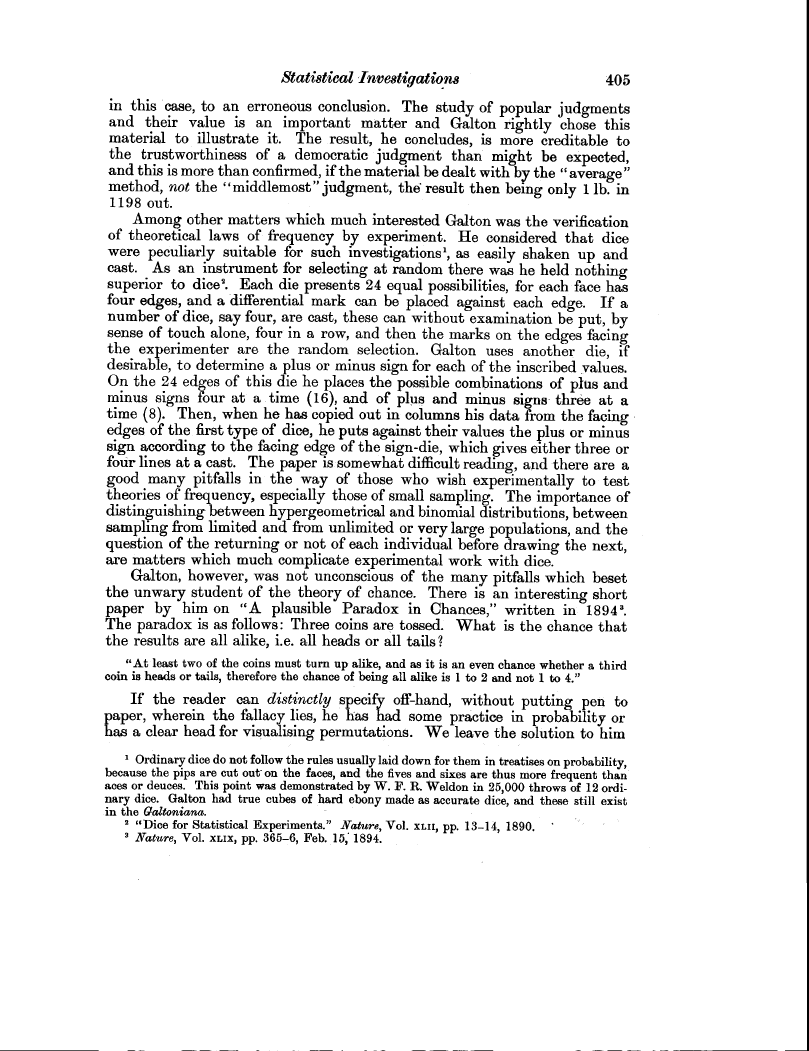Statistical Investigations 405
in this case, to an erroneous conclusion. The study of popular judgments and their value is an important matter and Galton rightly chose this material to illustrate it. The result, he concludes, is more creditable to the trustworthiness of a democratic judgment than might be expected, and this is more than confirmed, if the material be dealt with by the "average" method, not the " middlemost "judgment, the result then being only 1 lb. in
1198 out.
Among other matters which much interested Galton was the verification of theoretical laws of frequency by experiment. He considered that dice were peculiarly suitable for such investigations', as easily shaken up and cast. As an instrument for selecting at random there was he held nothing superior to dice'. Each die presents 24 equal possibilities, for each face has four edges, and a differential mark can be placed against each edge. If a number of dice, say four, are cast, these can without examination be put, by sense of touch alone, four in a row, and then the marks on the edges facing the experimenter are the random selection. Galton uses another die, if desirable, to determine a plus or minus sign for each of the inscribed values. On the 24 edges of this die he places the possible combinations of plus and minus signs four at a time (16), and of plus and minus signs three at a time (8). Then, when he has copied out in columns his data from the facing edges of the first type of dice, he puts against their values the plus or minus sign according to the facing edge of the sign-die, which gives either three or four lines at a cast. The paper is somewhat difficult reading, and there are a good many pitfalls in the way of those who wish experimentally to test theories of frequency, especially those of small sampling. The importance of distinguishing between hypergeometrical and binomial distributions, between sampling from limited and from unlimited or very large populations, and the question of the returning or not of each individual before drawing the next, are matters which much complicate experimental work with dice.
Galton, however, was not unconscious of the many pitfalls which beset the unwary student of the theory of chance. There is an interesting short paper by him on "A plausible Paradox in Chances," written in 1894'. The paradox is as follows : Three coins are tossed. What is the chance that the results are all alike, i.e. all heads or all tails?
"At least two of the coins must turn up alike, and as it is an even chance whether a third coin is heads or tails, therefore the chance of being all alike is 1 to 2 and not 1 to 4."
If the reader can distinctly specify off hand, without putting pen to paper, wherein the fallacy lies, he has had some practice in probability or has a clear head for visualising permutations. We leave the solution to him
' Ordinary dice do not follow the rules usually laid down for them in treatises on probability, because the pips are cut out- on the faces, and the fives and sixes are thus more frequent than aces or deuces. This point was demonstrated by W. F. R. Weldon in 25,000 throws of 12 ordinary dice. Galton had true cubes of hard ebony made as accurate dice, and these still exist in the Galtoniana.
2 "Dice for Statistical Experiments." Nature, Vol. XLII, pp. 13-14, 1890. 3 Nature, Vol. XLIX, pp. 365-6, Feb. 15,'1894.

